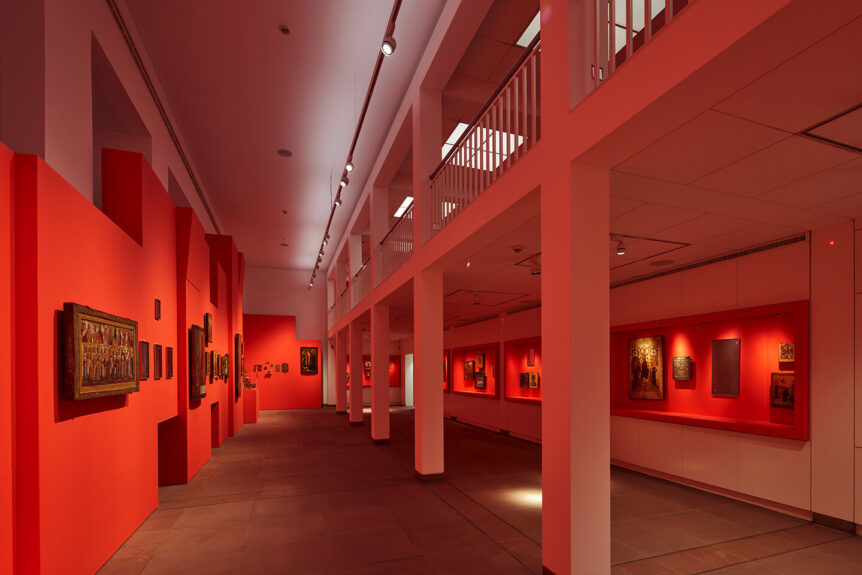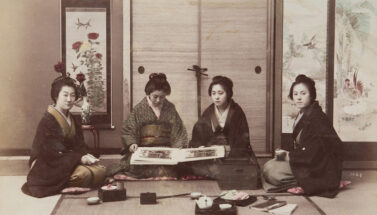Reopening of the Icon Museum Frankfurt
After more than a year of alterations and renovations, the Icon Museum in Frankfurt am Main is reopening with an entirely new exhibition space and concept. Frankfurt’s head of the Department of Culture, Dr Ina Hartwig, found the realisation of the new museum concept particularly convincing: ‘For the first time since its opening 30 yearsago, the Icon Museum has undergone extensive modernisation. In terms of its building structure, concept and digital technology, it has been brought up to date and given a complete revamp. With its new presentation and spatial concept, it not only enriches Frankfurt’s museum landscape, it also encourages understanding in our multicultural city.’
Under the direction of Prof. Matthias Wagner K and the curatorial leadership of Dr des. Konstanze Runge, who has held the position since September 2019, the museum places the relationship between people and icons at the centre of focus in its completely renewed exhibition.
The new exhibition concept
By including the foyer, the exhibition space could be expanded considerably. The foyer therefore becomes, in relation to both space and content, the starting point for the new permanent exhibition. It is here that the origin, distribution, manifold materiality, and visual language of icons are so brilliantly conveyed. This initial area is followed by the main space, where a greater immersion in the world of icons is made possible. This is achieved, on the one hand, through the roles of meaning and function pertaining to the icons in the Church and in domestic space and, on the other hand, in how the portrayals of the lives and Passions of Jesus and Mary are narratively staged. Whereas the main space is primarily dedicated to the presentation of the icons in an ecclesiastical context, the gallery’s intimate atmosphere contains an overwhelming sense of privacy. It is here that visitors encounter a host of saints, including the particularly revered Saint Nicholas and SaintGeorge. Following extensive conservation and restoration measures, the 130 selected icons and religious objects reveal an entirely fresh magnificence. At the same time, the rather typical traces of use were carefully conserved as a sign of the relationship between people and their icons. The icons are presented mostly without glass and at eye level. It is mainly the valuable and metal icons as well as small objects that are protected by glass and showcases.
Concerning her concept, the curatorial director Dr des. Konstanze Runge explained: ‘It is through the new museum concept that we wish to bring our visitors closer to the people behind the icons, providing them with the chance to experience the religious works of art in a totally new way. The collection was founded by Dr Jörgen Schmidt-Voigt and expanded through numerous outstanding loans, in particular 84 post-Byzantine icons from the Skulpturensammlung and the Museum of Byzantine Art Berlin. This offers us every opportunity to make the remarkably diverse and captivating Orthodox imagery from Russia, Greece and Romania, to Egypt and Ethiopia, accessible to a broad and international public. The timelessness of the icons is underscored by the modern architecture. A visit to our newly designed museum will convince you that icons still have a great deal to say to us today and, above all, tell us much about the people who create, admire, or collect them.’
‘Holy images were never the affair of religion alone, but also always of society, which expressed itself in and through religion,’ wrote the art historian Hans Belting in his book Likeness and Presence: A History of the Image before the Era of Art. ‘The controversy surrounding religious and aesthetic experiences that was sparked by thisbook has been given a relevant and profound impetus with the new design of the Icon Museum in Frankfurt am Main,’ said Prof. Matthias Wagner K. He then continued: ‘The design developed by Konstanze Runge and her assistant Simone Seyboldt enables visitors to understand the position the religious image finds itself overall within art and cultural history. Furthermore, it provides access to its meaning and application in people’s religious lives—which explains the link with the Museum Angewandte Kunst.’
The new presentation and spatial concept
Visitors can now discover the icons and other religious objects from Russia, Greece, Romania or Ethiopia in a completely fresh exhibition context, which was developed for gaining a direct experience of the sacred works of art. The room-within-a-room idea, which has been adapted to the requirements of the new permanent exhibition, picks up on the squares of Oswald Mathias Ungers’ postmodern architecture from the end of the 20th century and extends them horizontally and vertically. Through recesses, varying height dimensions, inclines, and projections, a change in this architecture is still possible. The elements are freestanding in that there are no direct wall connections and, while the historical architecture and Ungers’ modern architecture are partly visible, they are nonetheless always perceptible. The unrestrained, actually quite intensive monochrome colour scheme of the exhibition architecture, as well as the newly designed glass-free display cabinets, stand in clearcontrast to the whiteness of the building architecture. The highly pigmented colour forms an intentional lacklustre, yet extremely corporeal surface that brings the religious artworks to the fore— almost as though they were floating—and, together with the specially designed lighting and ultra-modern LED technology, creates an aesthetic basis for the staging of a new approach to content in the permanent exhibition.
Architectural background
With the advent of the Icon Museum in the baroque Deutschordenshaus in March 1990, the Museumsufer, which was initiated by Hilmar Hoffmann, had reached its eastern completion. According to the then city councillor and head of the building department Hanskarl Protzmann: ‘The construction of this museum involved the overall issue of overcoming the architectural challenge posed by replacing historical building material with new construction.’ It was through the architect Oswald Mathias Ungers that a designer was found who, in relation to the historical building structure and obvious differences, succeeded in creating a synthesis between old and new, so as to accommodate the extensive icon collection of Dr Jörgen Schmidt-Voigt’s foundation. After 30 years of its existence, the museum has undergone comprehensive refurbishment and renovation for the first time. The building facilities and air- conditioning systems have now been fully renewed, thus providing an ideal exhibition environment for the icons that are so susceptible to climatic fluctuations. The building’s security system has also been improved, as has the level of exhibition space available.
‘In a city with more than 14 Orthodox Christian churches and characterised by rich cultural diversity, the Icon Museum wishes not only to be a place for the preservation of cultural heritage, but also to be a space of encounter to which all are invited and which contributes to a successful coexistence of peoples from different cultural, religious and non- religious backgrounds. The responsibilities of a museum have changed significantly since the founding of Frankfurt’s Museumsufer, at the end of the 20th century. As head of the Department of Culture, Ms Hartwig concluded by saying: ‘With its altogether renewed concept, the Icon Museum has responded to the present-day challenges facing society.
*Photo: Main Room, Icon Museum Frankfurt. credit: lumenphoto.de
*Source: press release Museum Angewandte Kunst, 19.3.2021




